· part 1 ·
INTRODUCING THE DECKS
Most Visconti tarots are known under different names, and this might be
slightly confusing.
As an easy reference, the titles adopted in this page, in full, are those of the present
location of the cards: Brera-Brambilla Visconti,
Cary-Yale Visconti and
Pierpont-Morgan Bergamo Visconti-Sforza.
They respectively refer to the Brera Art Gallery (Milan), which holds all the cards
of the first deck (purchased by G.Brambilla around year 1900), the Cary Collection
in Yale University's Library (New Haven, U.S.A.), which also holds
all the cards of the second tarot, and the Pierpont-Morgan Library (New York)
which houses the largest nucleus of the third deck, 35 cards, while the remaining
39 subjects belong to two separate collections in Bergamo (Italy), one in the
Carrara Academy, and a private one.
The second deck is also known as Visconti di Modrone
(descendants of the Visconti family) and Gonzaga.
The third tarot is also known as Carrara, the name of the
gallery in Bergamo that now holds 26 of the cards, and Colleoni-Baglioni,
the families who previously owned them. The name Colleoni, though, may be easily mistaken
with other two different Colleoni tarots, of similar age, whose few
surviving subjects presently belong to the Victoria & Albert Museum (London) and to
a private collection (A.Cocchi), respectively. |
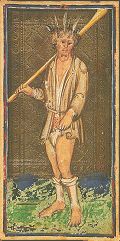
PMBVS ~ the Fool |
Furthermore, the names Bembo and
Cicognara (two among the alleged authors of
these cards, see WHO PAINTED THE DECKS?
in part 2) have also been used to indicate both the second and third tarot.
A summary of these names is shown in the following table, although for practical reasons
the captions of the pictures in these pages refer to the three decks with the
abbreviations of their names (BBV, CYV and PMBVS).
Brera-Brambilla Visconti
a.k.a.
Brambilla
Contessa di Mazzarino
|
|
Cary-Yale Visconti
a.k.a.
Visconti di Modrone
Gonzaga
Bembo
Cicognara |
|
Pierpont-Morgan Bergamo Visconti-Sforza
a.k.a.
Carrara
Colleoni-Baglioni
Bembo
Cicognara |
|

detail of a pip card from the CYV deck |
The cards of the Visconti tarots are made of thick cardboard.
The Brera-Brambilla deck is slightly curved in the center, the other two are flat.
All trumps and courts have a gold background; for pip cards (1 to 10), the background is silver
in the Brera-Brambilla and Cary-Yale tarots, while in the Pierpont-Morgan tarot it is
pale yellow with a multicolour floral pattern. A similar, more delicate floral
pattern appears on the outer border of each Cary-Yale card.
|
Gold and silver backgrounds feature textures with geometric shapes and family
devices made of tiny hammered dots.
Also some details of the illustrations are gold, especially in trumps and courts;
when not coloured, or where the paint has come off, they are barely
distinguishable from the background.
The coloured parts,instead, are hand-painted in vivid shades of red, blue, green, yellow and black. The overall
graphic effect is very close to that of illuminations in mediaeval books. |
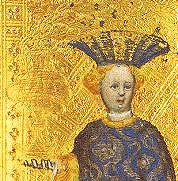
detail of a court card from the BBV deck |

detail of the hole
from a PMBVS card |
Many of the cards belonging to early tarot decks have a small
hole pierced through the upper frame: with very few exeptions, all punctures are exactly in the middle
and are very regular in shape; only a few have tears or jagged rims, or alterated colours
(as if the rust from a metal pin had bleeded over the paint). This suggests that in many
cases the cards might have been pinned to a board, or hung somewhere, for being kept on
display or for some other purpose. |
The cards of the Pierpont-Morgan deck measure about 85 x 175 mm.
(3¼ x 7 in.), the Brera-Brambilla deck is about
the same size, 80 x 178 mm., while the Cary-Yale tarot is even larger, 90 x 190 mm. (3½ x 7½ in.).
Although today these dimensions may appear unusual, comparing them to other cards of
similar age, the size of the Visconti tarots seems almost a standard, at least among the luxury
packs used in noble courts (as can be told from the ones seen in the picture on the
right).
However, also today's tarots are somewhat larger than an average Poker deck: this feature
has not been completely lost in time. |
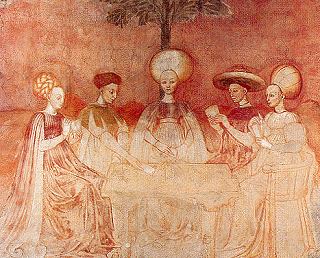
members of a court playing cards
(mid 15th century fresco in Palazzo Borromeo, Milan) |
HISTORICAL BACKGROUND
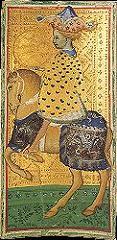
BBV
cavalier of Coins |
Who were the Visconti and Sforza families?
A historical flashback is needed to summarize the context in which the cards were produced,
and to understand the links between the two families to which these
tarots are so closely related.
Up to the 11th century, the ancestors of the Viscontis belonged to the minor
nobility of Lombardy region, in the north of Italy. This was not their actual name, but
when during the early 1200s they obtained the title of vice-counts (Italian: visconti),
they turned it into their family name.
The first outstanding member, Ottone Visconti (1207-95), was appointed archibishop of Milan
by pope Urban IV. After defeating a rival family, Della Torre, he claimed temporal
powers (a right Milan's archibishops had in earlier times), and then turned it into the
hands of his grand-nephew Matteo I (1250-1322), who became Lord of Milan.
This was the beginning of the dinasty's expansionist policy, which would have
lasted about 150 years. |
Meanwhile, in Rome, the pope disliked the growing power of the Visconti family, their friction
ending up in Matteo's excommunication in 1320, by John XXII.
During the 14th century, the Viscontis gained most part of
the surrounding territories. By those times, Europe was like a jigsaw puzzle of tiny autonomous states,
ruled by kings, lords, counts, dukes.
Among the famous members of the dinasty was Gian Galeazzo ("count of valour", 1351-1402,
grand-grand-son of Matteo).
He is remembered for having sponsored several men of literature,
such as Petrarch, and the for having started the making of Milan's cathedral and other important buildings, but,
as the rest of the family, his main goal was power. For this reason he married the
daughter of the king of France, to grant himself a strong ally.
Then, fearing to be overthrown by his uncle, the wicked Bernabò (1323-85), who ruled the eastern
half of the Visconti lands, he had him captured with a treacherous plot, imprisoned,
and - it is said - killed in jail.
Gian Galeazzo reunited the two halves of the land, and went on subduing other nearby territories.
By the end of the 14th century, the king of Germany and Holy Roman Emperor, Wenceslas,
appointed him hereditary Duke of Milan (apparently, after being payed for this). |
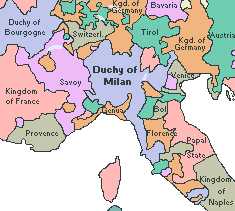
map showing northern Italy
around year 1400 |
Florence was the most important state which still resisted Gian Galeazzo's power.
In 1402, while towns as south as Pisa, Siena and Perugia had already been annexed to the
newborn Duchy of Milan, just before going to war against Florence, the duke unexpectedly died.
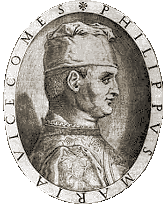
Filippo Maria Visconti |
Giovanni Maria (1388-1412), his eldest son, proved completely inept;
he is remembered as a tyrant, and was probably insane. After losing several territories
conquered by his father, he even caused the insurrection of some cities in Lombardy. In the
end, he was killed.
His younger brother, Filippo Maria (1392-1447), had to defeat Estorre, son of Barnabò, to
become Duke of Milan. As a ruler, he succeeded in taking hold again of the lost lands, backed
by the troops of Facino Cane, a late mercenary captain whose widow, Beatrice, he had
recently married.
But Filippo Maria soon sentenced her to death for adultery (...despite having himself a
mistress, who gave him two ilegitimate daughters!). He then married Maria of Savoy,
with the only purpose of establishing a strong alliance with the neighbor state.
The duke was described as a whimsical, neurotic person, who even disliked his new wife,
from whom he had no heirs.
However, he was able enough to improve the duchy's unwealthy economy by enhancing
trades and commerce. |
When in 1447 Venice's armies threatened Milan, Filippo Maria called for help on
Francesco Sforza, the husband of his eldest ilegitimate daughter, Bianca Maria. He too was a
mercenary captain, who during the previous years had already led Florence's and Venice's troops
against Milan. Money and thirst for fame could make these captains change side quite easily.
Curiously, also Francesco's family name had recently changed: his father, Muzio Attendolo,
a famous military man, had been nicknamed Sforza ("strength"), and had chosen
this to be their new surname. |
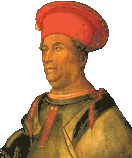
Francesco Sforza |
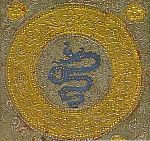
a famous Visconti device, used also
by the Sforza family: the snake |
In the same year 1447, Filippo Maria Visconti died. The lack of a male heir caused a
clash for the succession between Alfonso V of Aragon, king of Naples, who had been
designated by the duke as his legal successor, and Francesco Sforza who instead claimed the
duchy, being Filippo's son-in-law. The latter succeeded in becoming the fourth Duke of Milan,
in 1450.
The Visconti name disappeared from the list of Lombardy's following rulers, although the
Sforzas retained some of the former family's heraldic crests and devices.
|
DATING THE DECKS
These tarots were probably painted around the mid 15th century,
but it would not be possible to give a more precise dating.
Due to the very high quality of their illustrations, they are believed to be a gift who important
members of the Visconti and Sforza families were presented with.
In particular, S.Kaplan suggested that these tarots might have been made on a special occasion,
such as a wedding or an anniversary. On these grounds, the sixth trump card,
Love or the Lovers, is the most interesting subject where to look for a
symbolic connection between these tarots and their owners. The Brera-Brambilla deck does no
longer have this subject, so only the remaining two may be discussed.

CYV
the Lovers |
In the Cary-Yale tarot, that some scholars believe to be older than the Pierpont-Morgan deck, the Lovers are shown as a couple holding each other's hands under a canopy, above which a blindfolded cupid spreads his wings. On the ground is a small white animal, maybe a hound (symbol of fidelity)
or a hermin (symbol of virginity).
The canopy's fringe bears a series of alternate shields with the Visconti snake and
the white cross of Savoy on a red background, what several scholars consider an identification
mark that points to Filippo Maria Visconti and his second wife Maria of Savoy (1428).
|
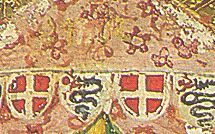
CYV
the Lovers (detail of the canopy) |
|
Also the Lovers card of the Pierpont-Morgan tarot shows
a couple holding each other's hand, here witnessed by a cupid standing on a small column, or pedestal.
Allegedly, the two personages are Francesco Sforza and Bianca Maria Visconti, who married in
1441; thus, we should assume that this tarot was manufactured later than the Cary-Yale one.
Other scholars, though, have claimed that the personages appearing in the Cary-Yale card
might be the son of Francesco Sforza, Galeazzo Maria, and his bride Bona of Savoy: in fact,
the serpent was among the devices retained by the Sforza family. Their marriage took place in
1468; therefore, should this theory prove reliable, the historical setting of the Cary-Yale tarot
would have to be shifted in time, some 20 years after the making of the Pierpont-Morgan deck. |
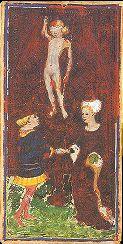
PMBVS
the Lovers |
Searching for clues among the subjects of the Cary-Yale tarot, several elements can be taken into consideration.

BBV
detail from the 10 of Coins |
In first place, the lack of Sforza devices among these cards is clearly in favour of the former theory, and so is the presence of Filippo Maria's name on the coinage used as pips in the suit of Coins, the gold ducato, on whose rim the words FILIP MARIA DUCHA can be faintly read. The same consideration can be made about the Brera-Brambilla tarot, whose pips feature a very similar coin (shown on the left), although in this case the text on the rim is not fully readable; some stylistical details seem to suggest that this other deck may be even slightly earlier than the Cary-Yale tarot.
Apparently, due to the duke's name on these coins, neither of the two decks could have been painted later than 1447, the year of Filippo maria's death.
|
Quite surprisingly, though, during Filippo Maria's reign only a silver coin (grosso) was stricken, while the gold ducato was first issued by Francesco Sforza. The actual coin featured the same cavalier as the one reproduced in both the aforesaid tarots, but with a more impersonal inscription, DUX MEDIOLANI, "duke (lord) of Milan", as the picture on the right clearly shows. But why such an important coin that Francesco Sforza had issued, and was certainly proud of, in these tarots bore the name of the previous ruler?
To play the part of the devil's advocate, we should also remark that Filippo Maria
Visconti barely tolerated his second wife Maria of Savoy (a well-known fact): it would have
been strange if this whimsical duke had commemorated such an unhappy wedding with a deck of cards. |
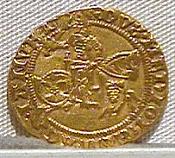
Francesco Sforza's gold ducato
(Museo Nazionale Romano) |
Furthermore, the painter who is presently credited as the author of these
tarots, in 1428 was still too young to be active (see
WHO PAINTED THE
DECKS?, in part 2), and it would have been even more unlikely for Filippo
Maria to have this tarot made for the 10th or 15th anniversary of his wedding.
Most elements seem to suggest that the so-called Cary-Yale Visconti tarot was painted while the Sforza family had already seized the duchy of Milan, but at the same time it celebrates only the name and devices of the previous duke, Filippo Maria.
In order to explain this apparently controversial situation, we may think that during his reign, Francesco Sforza may have dedicated a tribute to his predecessor and father-in-law by having two (or maybe more) commemorative tarots painted with Filippo Maria's name and family devices, which were also adopted by the Sforza. In these decks, the recently stricken
ducato coin might have been chosen as a source of inspiration for the pips in the suit of Coins, in honour of Francesco Sforza who had issued it.
Seen from the opposite end, the gold coin may have been fictional by the time the tarot was painted, and later on Francesco Sforza, inspired by the knight pattern, may have decided to strike a real one, with a different motto.
But since over six centuries have elapsed, these are (and will probably remain) only conjectures.
further reference to tarot decks can be found in Tom Tadfor Little's
The Hermitage
OTHER GALLERIES




















or back to

INTRODUCTION
AND HISTORY
|

MULTI-LANGUAGE
GLOSSARY |

THE FOOL &
THE JOKER |

INDEX
TABLE |

REGIONAL
GAMES |

PLAYING CARD
LINKS |